Effective Business Communication
VerifiedAdded on 2023/06/12
|15
|5021
|82
AI Summary
This article discusses the importance of effective business communication and how to diagnose and reflect on communication issues. It includes a literature review and provides tools for self-diagnosis. The article also discusses common communication issues such as failure to listen and cultural differences.
Contribute Materials
Your contribution can guide someone’s learning journey. Share your
documents today.
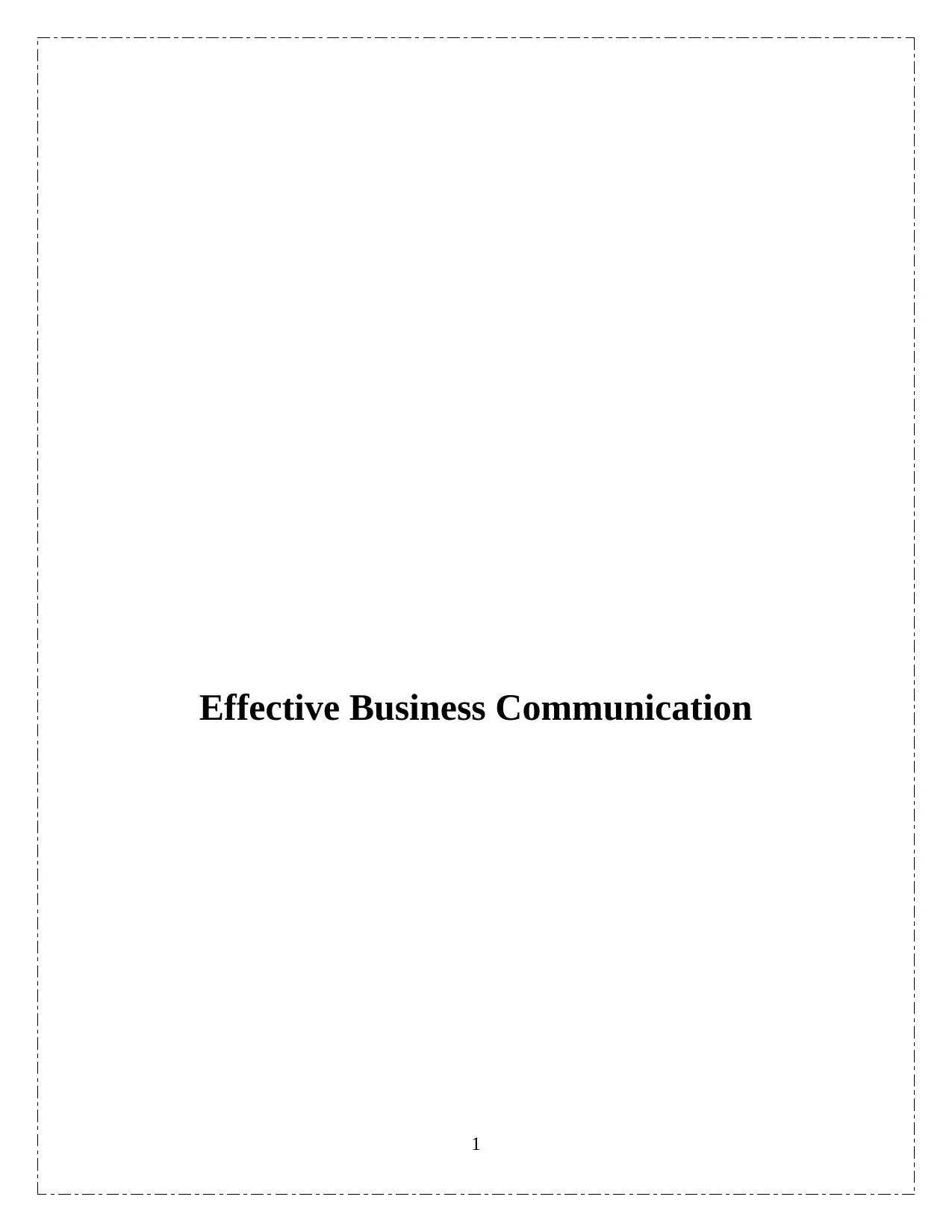
Effective Business Communication
1
1
Secure Best Marks with AI Grader
Need help grading? Try our AI Grader for instant feedback on your assignments.
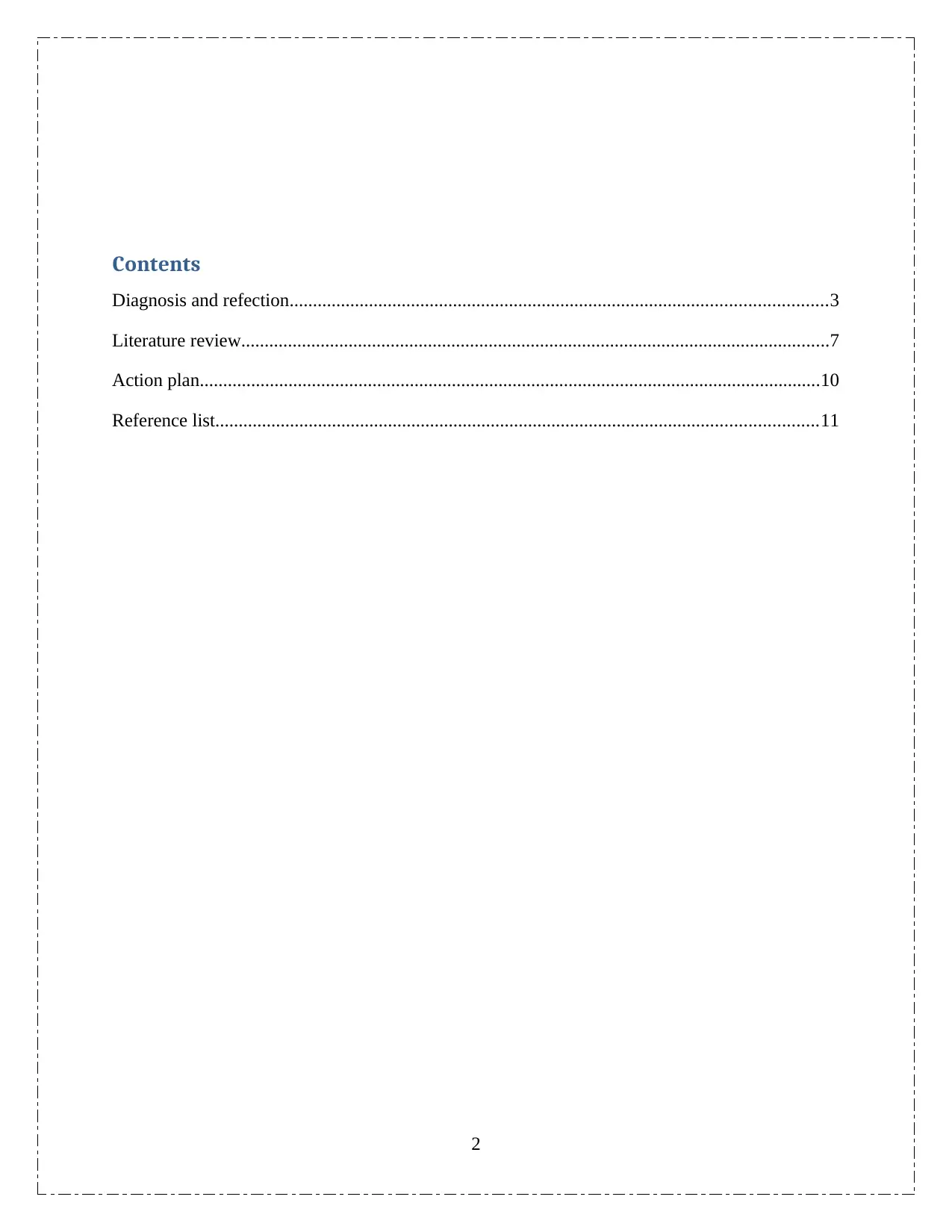
Contents
Diagnosis and refection...................................................................................................................3
Literature review..............................................................................................................................7
Action plan.....................................................................................................................................10
Reference list.................................................................................................................................11
2
Diagnosis and refection...................................................................................................................3
Literature review..............................................................................................................................7
Action plan.....................................................................................................................................10
Reference list.................................................................................................................................11
2
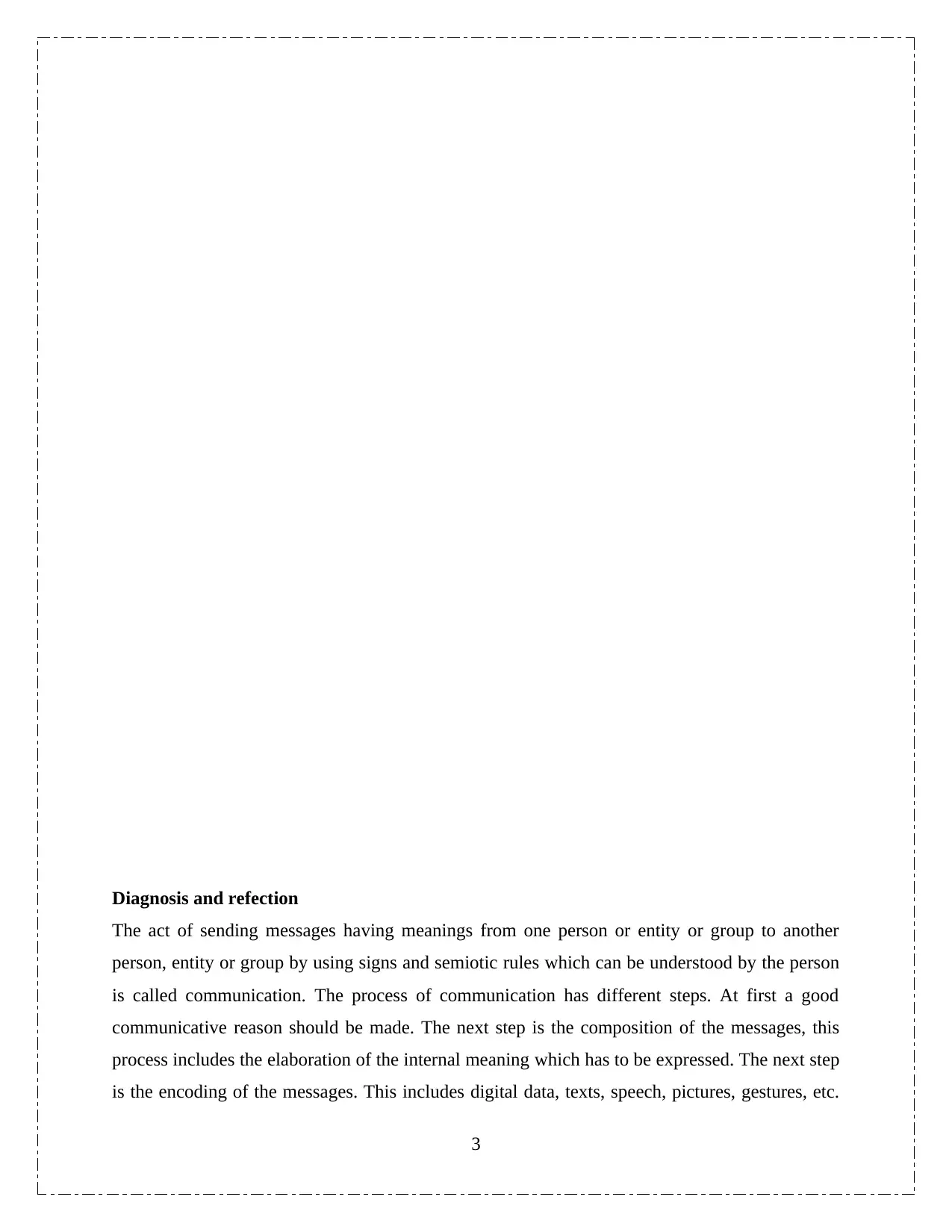
Diagnosis and refection
The act of sending messages having meanings from one person or entity or group to another
person, entity or group by using signs and semiotic rules which can be understood by the person
is called communication. The process of communication has different steps. At first a good
communicative reason should be made. The next step is the composition of the messages, this
process includes the elaboration of the internal meaning which has to be expressed. The next step
is the encoding of the messages. This includes digital data, texts, speech, pictures, gestures, etc.
3
The act of sending messages having meanings from one person or entity or group to another
person, entity or group by using signs and semiotic rules which can be understood by the person
is called communication. The process of communication has different steps. At first a good
communicative reason should be made. The next step is the composition of the messages, this
process includes the elaboration of the internal meaning which has to be expressed. The next step
is the encoding of the messages. This includes digital data, texts, speech, pictures, gestures, etc.
3
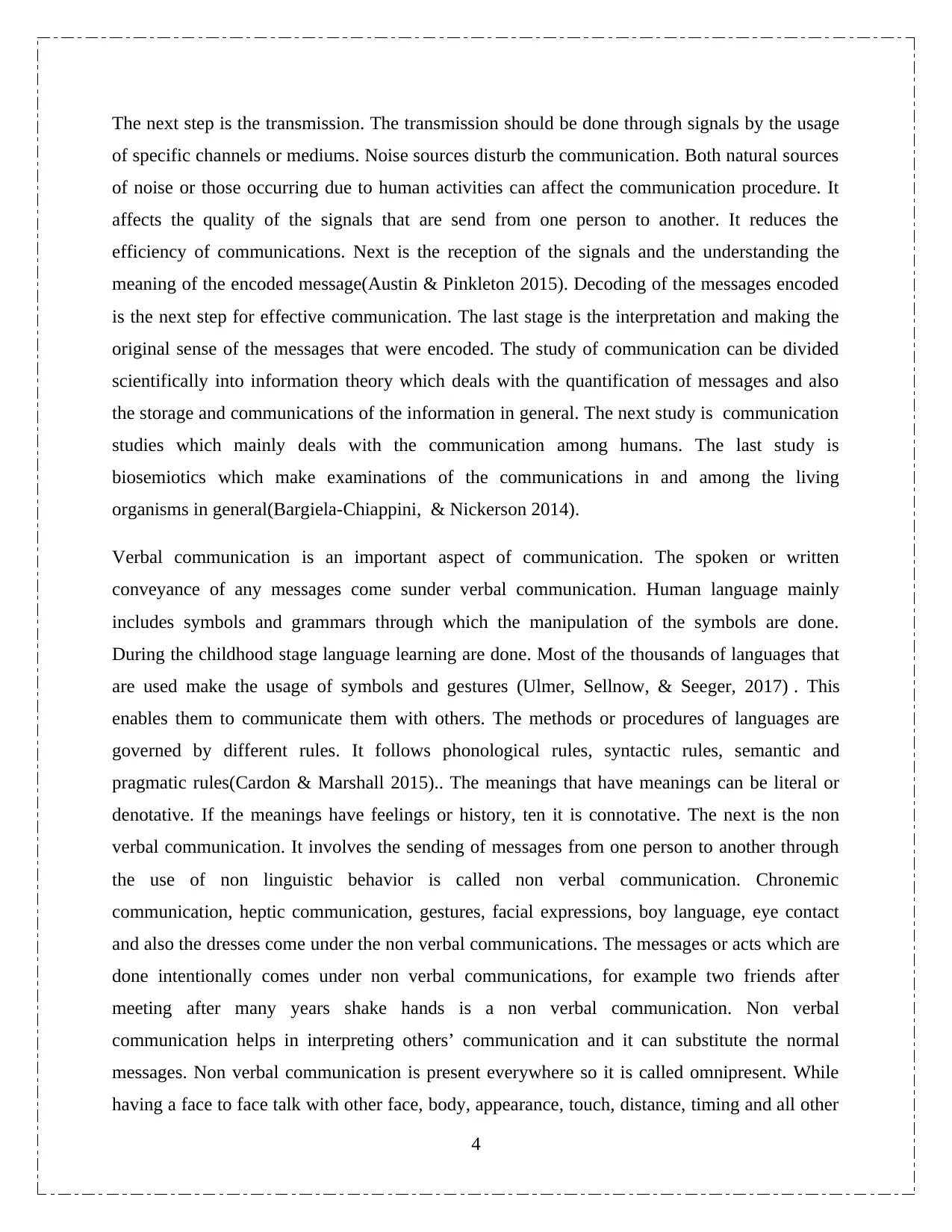
The next step is the transmission. The transmission should be done through signals by the usage
of specific channels or mediums. Noise sources disturb the communication. Both natural sources
of noise or those occurring due to human activities can affect the communication procedure. It
affects the quality of the signals that are send from one person to another. It reduces the
efficiency of communications. Next is the reception of the signals and the understanding the
meaning of the encoded message(Austin & Pinkleton 2015). Decoding of the messages encoded
is the next step for effective communication. The last stage is the interpretation and making the
original sense of the messages that were encoded. The study of communication can be divided
scientifically into information theory which deals with the quantification of messages and also
the storage and communications of the information in general. The next study is communication
studies which mainly deals with the communication among humans. The last study is
biosemiotics which make examinations of the communications in and among the living
organisms in general(Bargiela-Chiappini, & Nickerson 2014).
Verbal communication is an important aspect of communication. The spoken or written
conveyance of any messages come sunder verbal communication. Human language mainly
includes symbols and grammars through which the manipulation of the symbols are done.
During the childhood stage language learning are done. Most of the thousands of languages that
are used make the usage of symbols and gestures (Ulmer, Sellnow, & Seeger, 2017) . This
enables them to communicate them with others. The methods or procedures of languages are
governed by different rules. It follows phonological rules, syntactic rules, semantic and
pragmatic rules(Cardon & Marshall 2015).. The meanings that have meanings can be literal or
denotative. If the meanings have feelings or history, ten it is connotative. The next is the non
verbal communication. It involves the sending of messages from one person to another through
the use of non linguistic behavior is called non verbal communication. Chronemic
communication, heptic communication, gestures, facial expressions, boy language, eye contact
and also the dresses come under the non verbal communications. The messages or acts which are
done intentionally comes under non verbal communications, for example two friends after
meeting after many years shake hands is a non verbal communication. Non verbal
communication helps in interpreting others’ communication and it can substitute the normal
messages. Non verbal communication is present everywhere so it is called omnipresent. While
having a face to face talk with other face, body, appearance, touch, distance, timing and all other
4
of specific channels or mediums. Noise sources disturb the communication. Both natural sources
of noise or those occurring due to human activities can affect the communication procedure. It
affects the quality of the signals that are send from one person to another. It reduces the
efficiency of communications. Next is the reception of the signals and the understanding the
meaning of the encoded message(Austin & Pinkleton 2015). Decoding of the messages encoded
is the next step for effective communication. The last stage is the interpretation and making the
original sense of the messages that were encoded. The study of communication can be divided
scientifically into information theory which deals with the quantification of messages and also
the storage and communications of the information in general. The next study is communication
studies which mainly deals with the communication among humans. The last study is
biosemiotics which make examinations of the communications in and among the living
organisms in general(Bargiela-Chiappini, & Nickerson 2014).
Verbal communication is an important aspect of communication. The spoken or written
conveyance of any messages come sunder verbal communication. Human language mainly
includes symbols and grammars through which the manipulation of the symbols are done.
During the childhood stage language learning are done. Most of the thousands of languages that
are used make the usage of symbols and gestures (Ulmer, Sellnow, & Seeger, 2017) . This
enables them to communicate them with others. The methods or procedures of languages are
governed by different rules. It follows phonological rules, syntactic rules, semantic and
pragmatic rules(Cardon & Marshall 2015).. The meanings that have meanings can be literal or
denotative. If the meanings have feelings or history, ten it is connotative. The next is the non
verbal communication. It involves the sending of messages from one person to another through
the use of non linguistic behavior is called non verbal communication. Chronemic
communication, heptic communication, gestures, facial expressions, boy language, eye contact
and also the dresses come under the non verbal communications. The messages or acts which are
done intentionally comes under non verbal communications, for example two friends after
meeting after many years shake hands is a non verbal communication. Non verbal
communication helps in interpreting others’ communication and it can substitute the normal
messages. Non verbal communication is present everywhere so it is called omnipresent. While
having a face to face talk with other face, body, appearance, touch, distance, timing and all other
4
Secure Best Marks with AI Grader
Need help grading? Try our AI Grader for instant feedback on your assignments.

things are included, so it is a non verbal communication. Written communications are also a type
of non verbal communication. This communication has formed an universal communication
system. Smiling, crying, glaring, caring, etc. all comes under the non vrerbal communications
(Certo 2018).
Active listening is nothing but a technique of communication which is used for counseling,
training and to resolve the conflicts in resolution. This technique involves that the listener must
listen properly and accurately to what the speaker is saying. This method is opposed by reflective
listening where the listener say back all the things that are said by the speaker in order to make
the confirmation that he was listening to what he said (Wang, Pauleen, & Zhang, 2016). It also
involve that the listener should notice the speaker’s behavior and body language. If the listener
has the ability to perceive from the body language of the speaker, he can understand what the
speaker is going to say. Hearing properly the words of the speaker, the listener can paraphrase
the words of the speaker. Sometimes due to ineffective listening skills conflicts among the
listeners occur due to misunderstandings. Active listening are applicable in a variety of situations
like advocacy, community organizations, while tutoring, medical workers when communicate
with the patients, etc (Deeley 2018)..
There are different communication self diagnostic tools. One of the tools is self-perceived
communication competence scale (SPCC). The efficacy of people for communicating vary a lot.
Some people can communicate properly at one place with some persons while he may not
communicate properly at other place while communicating with some other persons. In this case
my score is 81. The result has been made by making calculations considering talking to a group
of strangers, talking with an acquaintance, while talking in a large meeting of friends, while
talking in a small group of strangers, talking with a friend, talking in a large meeting of
acquaintance, while presenting a talk to a group of friends, talking in a small group of
acquaintances, talking while large meeting of strangers and while talking in a small group of
friends. So I have medium SPCC while talking in public (80%), in meeting (75%), in ground
(80.6%), in front of stranger (78%), in acquaintance (80%), in front of friend (85%). So the total
percentage is 80.96%.( Doan, & McKie 2017).
Another tool is non verbal immediacy scale self report. Nonverbal immediacy are behaviors that
mainly give positive feelings towards the person who is listening or the other persons present.
5
of non verbal communication. This communication has formed an universal communication
system. Smiling, crying, glaring, caring, etc. all comes under the non vrerbal communications
(Certo 2018).
Active listening is nothing but a technique of communication which is used for counseling,
training and to resolve the conflicts in resolution. This technique involves that the listener must
listen properly and accurately to what the speaker is saying. This method is opposed by reflective
listening where the listener say back all the things that are said by the speaker in order to make
the confirmation that he was listening to what he said (Wang, Pauleen, & Zhang, 2016). It also
involve that the listener should notice the speaker’s behavior and body language. If the listener
has the ability to perceive from the body language of the speaker, he can understand what the
speaker is going to say. Hearing properly the words of the speaker, the listener can paraphrase
the words of the speaker. Sometimes due to ineffective listening skills conflicts among the
listeners occur due to misunderstandings. Active listening are applicable in a variety of situations
like advocacy, community organizations, while tutoring, medical workers when communicate
with the patients, etc (Deeley 2018)..
There are different communication self diagnostic tools. One of the tools is self-perceived
communication competence scale (SPCC). The efficacy of people for communicating vary a lot.
Some people can communicate properly at one place with some persons while he may not
communicate properly at other place while communicating with some other persons. In this case
my score is 81. The result has been made by making calculations considering talking to a group
of strangers, talking with an acquaintance, while talking in a large meeting of friends, while
talking in a small group of strangers, talking with a friend, talking in a large meeting of
acquaintance, while presenting a talk to a group of friends, talking in a small group of
acquaintances, talking while large meeting of strangers and while talking in a small group of
friends. So I have medium SPCC while talking in public (80%), in meeting (75%), in ground
(80.6%), in front of stranger (78%), in acquaintance (80%), in front of friend (85%). So the total
percentage is 80.96%.( Doan, & McKie 2017).
Another tool is non verbal immediacy scale self report. Nonverbal immediacy are behaviors that
mainly give positive feelings towards the person who is listening or the other persons present.
5
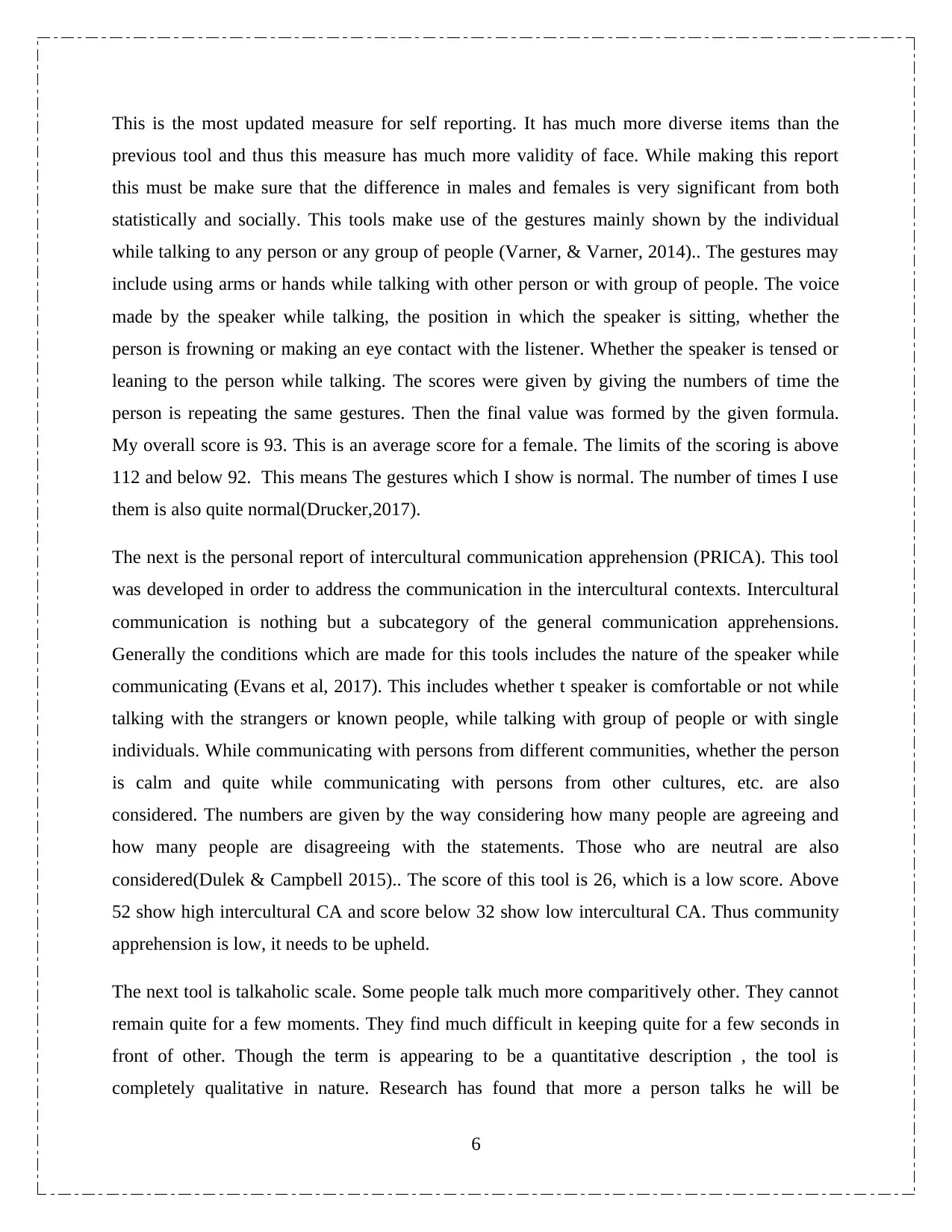
This is the most updated measure for self reporting. It has much more diverse items than the
previous tool and thus this measure has much more validity of face. While making this report
this must be make sure that the difference in males and females is very significant from both
statistically and socially. This tools make use of the gestures mainly shown by the individual
while talking to any person or any group of people (Varner, & Varner, 2014).. The gestures may
include using arms or hands while talking with other person or with group of people. The voice
made by the speaker while talking, the position in which the speaker is sitting, whether the
person is frowning or making an eye contact with the listener. Whether the speaker is tensed or
leaning to the person while talking. The scores were given by giving the numbers of time the
person is repeating the same gestures. Then the final value was formed by the given formula.
My overall score is 93. This is an average score for a female. The limits of the scoring is above
112 and below 92. This means The gestures which I show is normal. The number of times I use
them is also quite normal(Drucker,2017).
The next is the personal report of intercultural communication apprehension (PRICA). This tool
was developed in order to address the communication in the intercultural contexts. Intercultural
communication is nothing but a subcategory of the general communication apprehensions.
Generally the conditions which are made for this tools includes the nature of the speaker while
communicating (Evans et al, 2017). This includes whether t speaker is comfortable or not while
talking with the strangers or known people, while talking with group of people or with single
individuals. While communicating with persons from different communities, whether the person
is calm and quite while communicating with persons from other cultures, etc. are also
considered. The numbers are given by the way considering how many people are agreeing and
how many people are disagreeing with the statements. Those who are neutral are also
considered(Dulek & Campbell 2015).. The score of this tool is 26, which is a low score. Above
52 show high intercultural CA and score below 32 show low intercultural CA. Thus community
apprehension is low, it needs to be upheld.
The next tool is talkaholic scale. Some people talk much more comparitively other. They cannot
remain quite for a few moments. They find much difficult in keeping quite for a few seconds in
front of other. Though the term is appearing to be a quantitative description , the tool is
completely qualitative in nature. Research has found that more a person talks he will be
6
previous tool and thus this measure has much more validity of face. While making this report
this must be make sure that the difference in males and females is very significant from both
statistically and socially. This tools make use of the gestures mainly shown by the individual
while talking to any person or any group of people (Varner, & Varner, 2014).. The gestures may
include using arms or hands while talking with other person or with group of people. The voice
made by the speaker while talking, the position in which the speaker is sitting, whether the
person is frowning or making an eye contact with the listener. Whether the speaker is tensed or
leaning to the person while talking. The scores were given by giving the numbers of time the
person is repeating the same gestures. Then the final value was formed by the given formula.
My overall score is 93. This is an average score for a female. The limits of the scoring is above
112 and below 92. This means The gestures which I show is normal. The number of times I use
them is also quite normal(Drucker,2017).
The next is the personal report of intercultural communication apprehension (PRICA). This tool
was developed in order to address the communication in the intercultural contexts. Intercultural
communication is nothing but a subcategory of the general communication apprehensions.
Generally the conditions which are made for this tools includes the nature of the speaker while
communicating (Evans et al, 2017). This includes whether t speaker is comfortable or not while
talking with the strangers or known people, while talking with group of people or with single
individuals. While communicating with persons from different communities, whether the person
is calm and quite while communicating with persons from other cultures, etc. are also
considered. The numbers are given by the way considering how many people are agreeing and
how many people are disagreeing with the statements. Those who are neutral are also
considered(Dulek & Campbell 2015).. The score of this tool is 26, which is a low score. Above
52 show high intercultural CA and score below 32 show low intercultural CA. Thus community
apprehension is low, it needs to be upheld.
The next tool is talkaholic scale. Some people talk much more comparitively other. They cannot
remain quite for a few moments. They find much difficult in keeping quite for a few seconds in
front of other. Though the term is appearing to be a quantitative description , the tool is
completely qualitative in nature. Research has found that more a person talks he will be
6
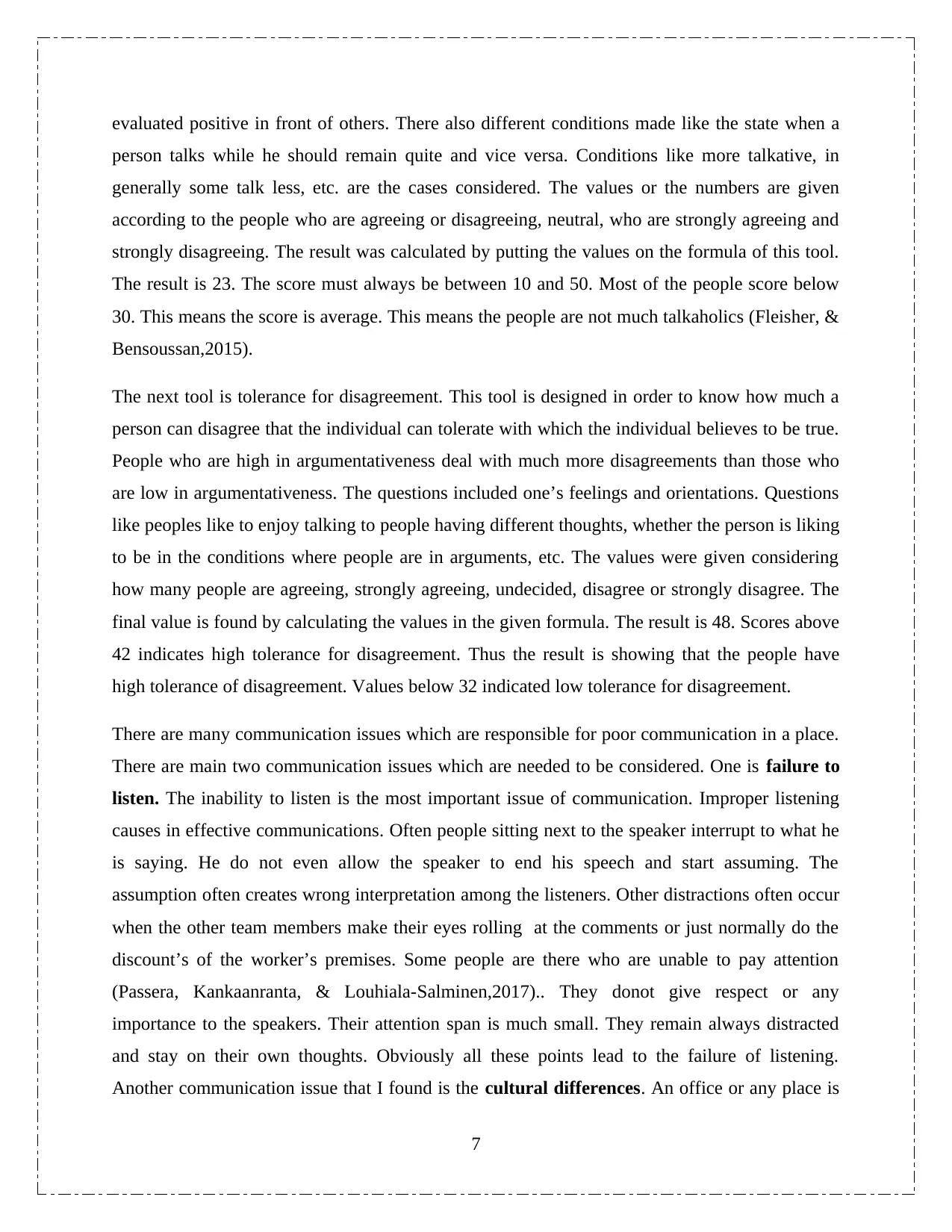
evaluated positive in front of others. There also different conditions made like the state when a
person talks while he should remain quite and vice versa. Conditions like more talkative, in
generally some talk less, etc. are the cases considered. The values or the numbers are given
according to the people who are agreeing or disagreeing, neutral, who are strongly agreeing and
strongly disagreeing. The result was calculated by putting the values on the formula of this tool.
The result is 23. The score must always be between 10 and 50. Most of the people score below
30. This means the score is average. This means the people are not much talkaholics (Fleisher, &
Bensoussan,2015).
The next tool is tolerance for disagreement. This tool is designed in order to know how much a
person can disagree that the individual can tolerate with which the individual believes to be true.
People who are high in argumentativeness deal with much more disagreements than those who
are low in argumentativeness. The questions included one’s feelings and orientations. Questions
like peoples like to enjoy talking to people having different thoughts, whether the person is liking
to be in the conditions where people are in arguments, etc. The values were given considering
how many people are agreeing, strongly agreeing, undecided, disagree or strongly disagree. The
final value is found by calculating the values in the given formula. The result is 48. Scores above
42 indicates high tolerance for disagreement. Thus the result is showing that the people have
high tolerance of disagreement. Values below 32 indicated low tolerance for disagreement.
There are many communication issues which are responsible for poor communication in a place.
There are main two communication issues which are needed to be considered. One is failure to
listen. The inability to listen is the most important issue of communication. Improper listening
causes in effective communications. Often people sitting next to the speaker interrupt to what he
is saying. He do not even allow the speaker to end his speech and start assuming. The
assumption often creates wrong interpretation among the listeners. Other distractions often occur
when the other team members make their eyes rolling at the comments or just normally do the
discount’s of the worker’s premises. Some people are there who are unable to pay attention
(Passera, Kankaanranta, & Louhiala-Salminen,2017).. They donot give respect or any
importance to the speakers. Their attention span is much small. They remain always distracted
and stay on their own thoughts. Obviously all these points lead to the failure of listening.
Another communication issue that I found is the cultural differences. An office or any place is
7
person talks while he should remain quite and vice versa. Conditions like more talkative, in
generally some talk less, etc. are the cases considered. The values or the numbers are given
according to the people who are agreeing or disagreeing, neutral, who are strongly agreeing and
strongly disagreeing. The result was calculated by putting the values on the formula of this tool.
The result is 23. The score must always be between 10 and 50. Most of the people score below
30. This means the score is average. This means the people are not much talkaholics (Fleisher, &
Bensoussan,2015).
The next tool is tolerance for disagreement. This tool is designed in order to know how much a
person can disagree that the individual can tolerate with which the individual believes to be true.
People who are high in argumentativeness deal with much more disagreements than those who
are low in argumentativeness. The questions included one’s feelings and orientations. Questions
like peoples like to enjoy talking to people having different thoughts, whether the person is liking
to be in the conditions where people are in arguments, etc. The values were given considering
how many people are agreeing, strongly agreeing, undecided, disagree or strongly disagree. The
final value is found by calculating the values in the given formula. The result is 48. Scores above
42 indicates high tolerance for disagreement. Thus the result is showing that the people have
high tolerance of disagreement. Values below 32 indicated low tolerance for disagreement.
There are many communication issues which are responsible for poor communication in a place.
There are main two communication issues which are needed to be considered. One is failure to
listen. The inability to listen is the most important issue of communication. Improper listening
causes in effective communications. Often people sitting next to the speaker interrupt to what he
is saying. He do not even allow the speaker to end his speech and start assuming. The
assumption often creates wrong interpretation among the listeners. Other distractions often occur
when the other team members make their eyes rolling at the comments or just normally do the
discount’s of the worker’s premises. Some people are there who are unable to pay attention
(Passera, Kankaanranta, & Louhiala-Salminen,2017).. They donot give respect or any
importance to the speakers. Their attention span is much small. They remain always distracted
and stay on their own thoughts. Obviously all these points lead to the failure of listening.
Another communication issue that I found is the cultural differences. An office or any place is
7
Paraphrase This Document
Need a fresh take? Get an instant paraphrase of this document with our AI Paraphraser
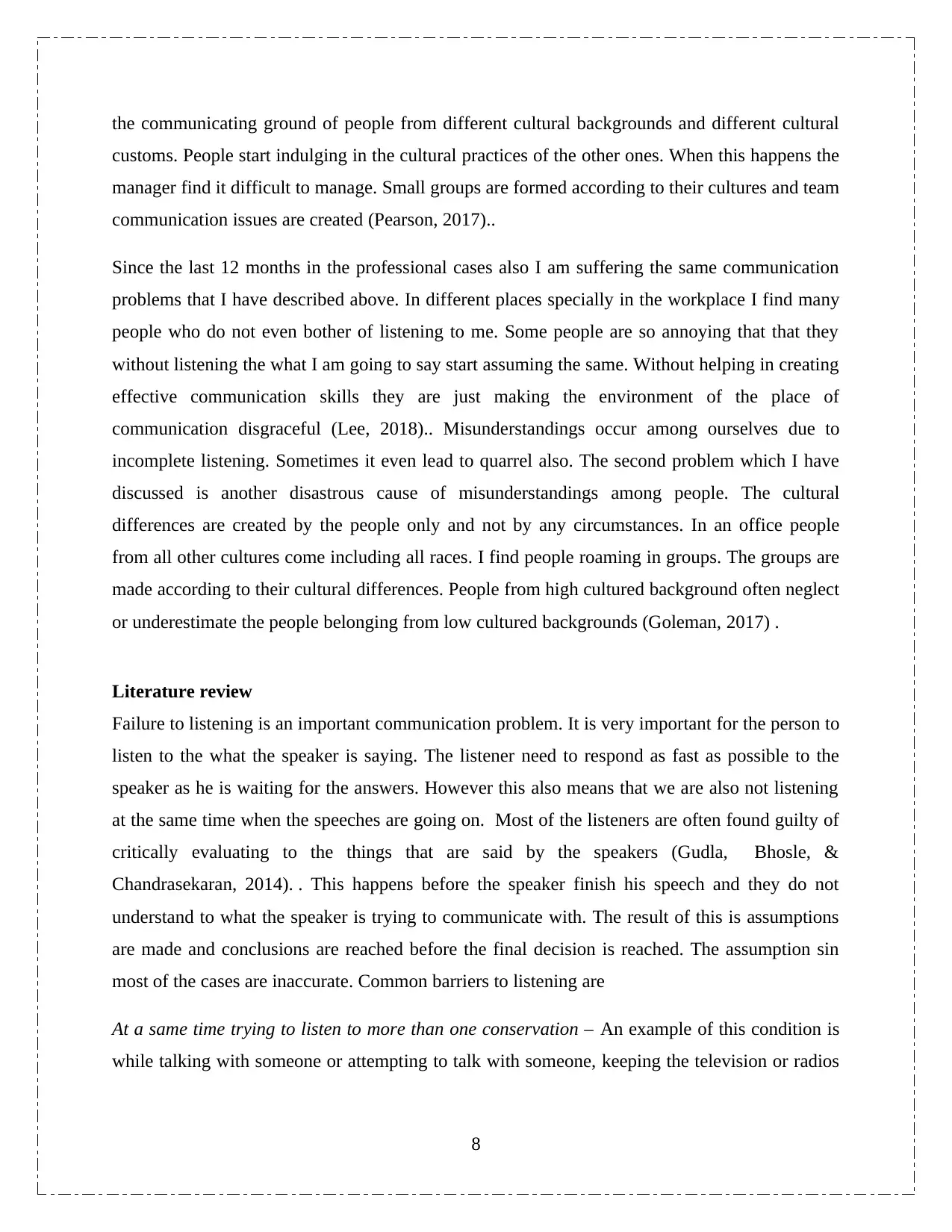
the communicating ground of people from different cultural backgrounds and different cultural
customs. People start indulging in the cultural practices of the other ones. When this happens the
manager find it difficult to manage. Small groups are formed according to their cultures and team
communication issues are created (Pearson, 2017)..
Since the last 12 months in the professional cases also I am suffering the same communication
problems that I have described above. In different places specially in the workplace I find many
people who do not even bother of listening to me. Some people are so annoying that that they
without listening the what I am going to say start assuming the same. Without helping in creating
effective communication skills they are just making the environment of the place of
communication disgraceful (Lee, 2018).. Misunderstandings occur among ourselves due to
incomplete listening. Sometimes it even lead to quarrel also. The second problem which I have
discussed is another disastrous cause of misunderstandings among people. The cultural
differences are created by the people only and not by any circumstances. In an office people
from all other cultures come including all races. I find people roaming in groups. The groups are
made according to their cultural differences. People from high cultured background often neglect
or underestimate the people belonging from low cultured backgrounds (Goleman, 2017) .
Literature review
Failure to listening is an important communication problem. It is very important for the person to
listen to the what the speaker is saying. The listener need to respond as fast as possible to the
speaker as he is waiting for the answers. However this also means that we are also not listening
at the same time when the speeches are going on. Most of the listeners are often found guilty of
critically evaluating to the things that are said by the speakers (Gudla, Bhosle, &
Chandrasekaran, 2014). . This happens before the speaker finish his speech and they do not
understand to what the speaker is trying to communicate with. The result of this is assumptions
are made and conclusions are reached before the final decision is reached. The assumption sin
most of the cases are inaccurate. Common barriers to listening are
At a same time trying to listen to more than one conservation – An example of this condition is
while talking with someone or attempting to talk with someone, keeping the television or radios
8
customs. People start indulging in the cultural practices of the other ones. When this happens the
manager find it difficult to manage. Small groups are formed according to their cultures and team
communication issues are created (Pearson, 2017)..
Since the last 12 months in the professional cases also I am suffering the same communication
problems that I have described above. In different places specially in the workplace I find many
people who do not even bother of listening to me. Some people are so annoying that that they
without listening the what I am going to say start assuming the same. Without helping in creating
effective communication skills they are just making the environment of the place of
communication disgraceful (Lee, 2018).. Misunderstandings occur among ourselves due to
incomplete listening. Sometimes it even lead to quarrel also. The second problem which I have
discussed is another disastrous cause of misunderstandings among people. The cultural
differences are created by the people only and not by any circumstances. In an office people
from all other cultures come including all races. I find people roaming in groups. The groups are
made according to their cultural differences. People from high cultured background often neglect
or underestimate the people belonging from low cultured backgrounds (Goleman, 2017) .
Literature review
Failure to listening is an important communication problem. It is very important for the person to
listen to the what the speaker is saying. The listener need to respond as fast as possible to the
speaker as he is waiting for the answers. However this also means that we are also not listening
at the same time when the speeches are going on. Most of the listeners are often found guilty of
critically evaluating to the things that are said by the speakers (Gudla, Bhosle, &
Chandrasekaran, 2014). . This happens before the speaker finish his speech and they do not
understand to what the speaker is trying to communicate with. The result of this is assumptions
are made and conclusions are reached before the final decision is reached. The assumption sin
most of the cases are inaccurate. Common barriers to listening are
At a same time trying to listen to more than one conservation – An example of this condition is
while talking with someone or attempting to talk with someone, keeping the television or radios
8
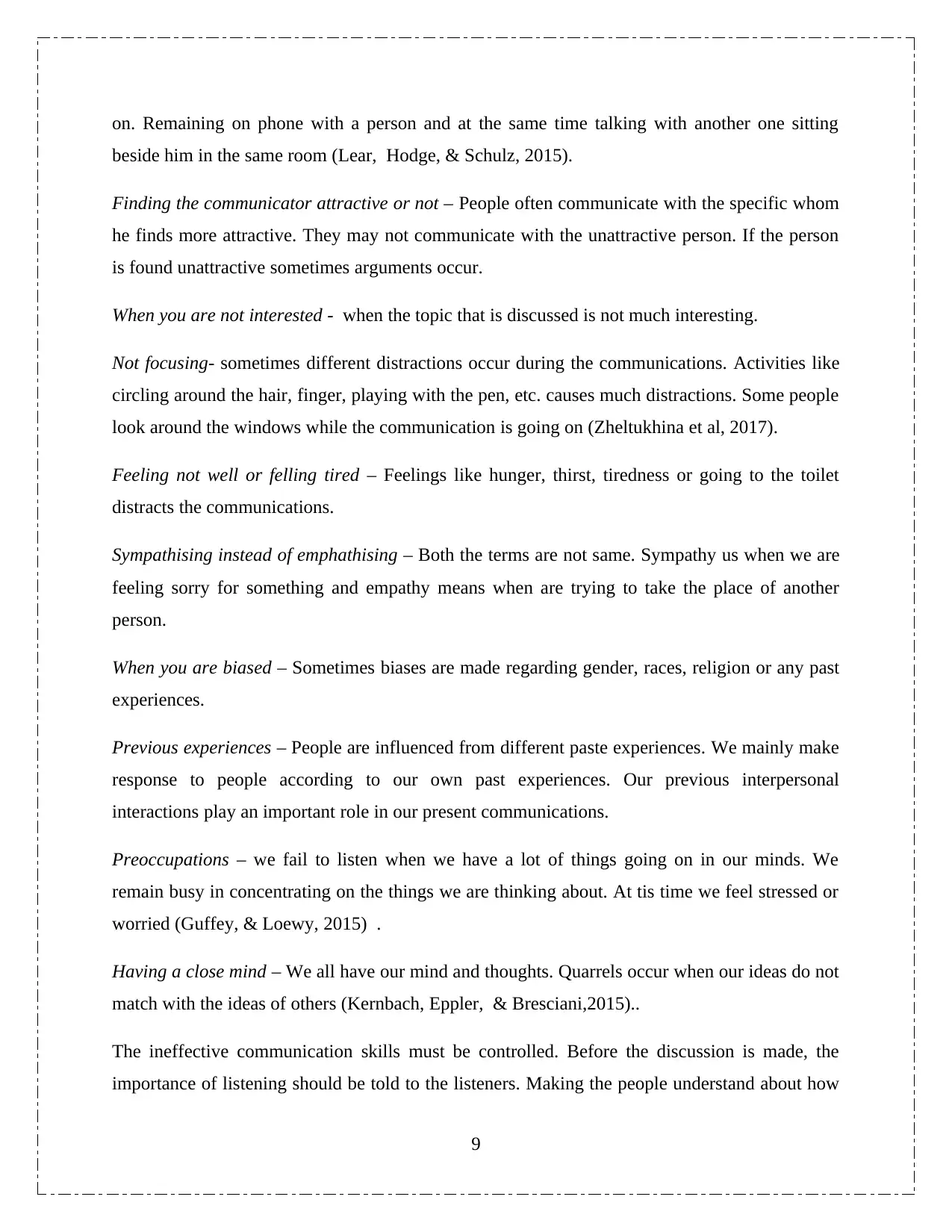
on. Remaining on phone with a person and at the same time talking with another one sitting
beside him in the same room (Lear, Hodge, & Schulz, 2015).
Finding the communicator attractive or not – People often communicate with the specific whom
he finds more attractive. They may not communicate with the unattractive person. If the person
is found unattractive sometimes arguments occur.
When you are not interested - when the topic that is discussed is not much interesting.
Not focusing- sometimes different distractions occur during the communications. Activities like
circling around the hair, finger, playing with the pen, etc. causes much distractions. Some people
look around the windows while the communication is going on (Zheltukhina et al, 2017).
Feeling not well or felling tired – Feelings like hunger, thirst, tiredness or going to the toilet
distracts the communications.
Sympathising instead of emphathising – Both the terms are not same. Sympathy us when we are
feeling sorry for something and empathy means when are trying to take the place of another
person.
When you are biased – Sometimes biases are made regarding gender, races, religion or any past
experiences.
Previous experiences – People are influenced from different paste experiences. We mainly make
response to people according to our own past experiences. Our previous interpersonal
interactions play an important role in our present communications.
Preoccupations – we fail to listen when we have a lot of things going on in our minds. We
remain busy in concentrating on the things we are thinking about. At tis time we feel stressed or
worried (Guffey, & Loewy, 2015) .
Having a close mind – We all have our mind and thoughts. Quarrels occur when our ideas do not
match with the ideas of others (Kernbach, Eppler, & Bresciani,2015)..
The ineffective communication skills must be controlled. Before the discussion is made, the
importance of listening should be told to the listeners. Making the people understand about how
9
beside him in the same room (Lear, Hodge, & Schulz, 2015).
Finding the communicator attractive or not – People often communicate with the specific whom
he finds more attractive. They may not communicate with the unattractive person. If the person
is found unattractive sometimes arguments occur.
When you are not interested - when the topic that is discussed is not much interesting.
Not focusing- sometimes different distractions occur during the communications. Activities like
circling around the hair, finger, playing with the pen, etc. causes much distractions. Some people
look around the windows while the communication is going on (Zheltukhina et al, 2017).
Feeling not well or felling tired – Feelings like hunger, thirst, tiredness or going to the toilet
distracts the communications.
Sympathising instead of emphathising – Both the terms are not same. Sympathy us when we are
feeling sorry for something and empathy means when are trying to take the place of another
person.
When you are biased – Sometimes biases are made regarding gender, races, religion or any past
experiences.
Previous experiences – People are influenced from different paste experiences. We mainly make
response to people according to our own past experiences. Our previous interpersonal
interactions play an important role in our present communications.
Preoccupations – we fail to listen when we have a lot of things going on in our minds. We
remain busy in concentrating on the things we are thinking about. At tis time we feel stressed or
worried (Guffey, & Loewy, 2015) .
Having a close mind – We all have our mind and thoughts. Quarrels occur when our ideas do not
match with the ideas of others (Kernbach, Eppler, & Bresciani,2015)..
The ineffective communication skills must be controlled. Before the discussion is made, the
importance of listening should be told to the listeners. Making the people understand about how
9

the inattention keeps the people away from all the learning skills. Suggestion should be given
about taking the notes of the discussions so that they can learn about the things later also.
In the cultural differences language barrier is one of the important cause. Though apart from the
language barriers other cultural barriers are also present.
Language barriers- Language is a very complex thing as well the most important thing for
communicating with other persons. People look around the world through the mode of his
language only. Sometimes it becomes difficult by the skilled translators communicating in the
other language. When you think that how many times misunderstanding occurs with someone
speaking in the same language, then how difficult it becomes while taking with people talking in
different languages (Hargie, 2016). .
Hostile stereotypes – Some people are stereotypes. In workplace the ideas from the stereotypes
people causes barriers in communication. Stereotypes are nothing but assumptions made by
people about the traits of the group members. As for example – a stereotypical American person
is very much impatient as well as very arrogant but at the same time he is friendly and much
tolerant. There is a danger while entertaining the stereotypes, that is he is having the
characteristics that are due to the reason they are a part of the group. Although not all Americans
are impatient and arrogant and also not all Americans are friendly and tolerant. Before
communication judging of an individual causes miscommunication.
Behavior differences – The differences in behavior among the workers of different cultures lead
to miscommunications in the workplace. Each and every cultures have their own guidelines
which they consider as perfect. In some cultures even looking at the eyes while talking are
considered as disgraceful. In term of business always to the point talking should be done.
Similarly in some cultures space is given while taking to each other while in some other cultures
they closely stand with one another while talking (Holmes, & Parker, 2017)..
Emotional display – The inappropriate disclosure of emotions may vary from culture to cultures.
In some countries in business settings displaying of anger, frustrations or fear are considered
inappropriate. People from these cultures hide their emotions and only discuss about the aspects
of the situation. In some other countries, the participants are allowed to discuss, to reveal their
10
about taking the notes of the discussions so that they can learn about the things later also.
In the cultural differences language barrier is one of the important cause. Though apart from the
language barriers other cultural barriers are also present.
Language barriers- Language is a very complex thing as well the most important thing for
communicating with other persons. People look around the world through the mode of his
language only. Sometimes it becomes difficult by the skilled translators communicating in the
other language. When you think that how many times misunderstanding occurs with someone
speaking in the same language, then how difficult it becomes while taking with people talking in
different languages (Hargie, 2016). .
Hostile stereotypes – Some people are stereotypes. In workplace the ideas from the stereotypes
people causes barriers in communication. Stereotypes are nothing but assumptions made by
people about the traits of the group members. As for example – a stereotypical American person
is very much impatient as well as very arrogant but at the same time he is friendly and much
tolerant. There is a danger while entertaining the stereotypes, that is he is having the
characteristics that are due to the reason they are a part of the group. Although not all Americans
are impatient and arrogant and also not all Americans are friendly and tolerant. Before
communication judging of an individual causes miscommunication.
Behavior differences – The differences in behavior among the workers of different cultures lead
to miscommunications in the workplace. Each and every cultures have their own guidelines
which they consider as perfect. In some cultures even looking at the eyes while talking are
considered as disgraceful. In term of business always to the point talking should be done.
Similarly in some cultures space is given while taking to each other while in some other cultures
they closely stand with one another while talking (Holmes, & Parker, 2017)..
Emotional display – The inappropriate disclosure of emotions may vary from culture to cultures.
In some countries in business settings displaying of anger, frustrations or fear are considered
inappropriate. People from these cultures hide their emotions and only discuss about the aspects
of the situation. In some other countries, the participants are allowed to discuss, to reveal their
10
Secure Best Marks with AI Grader
Need help grading? Try our AI Grader for instant feedback on your assignments.
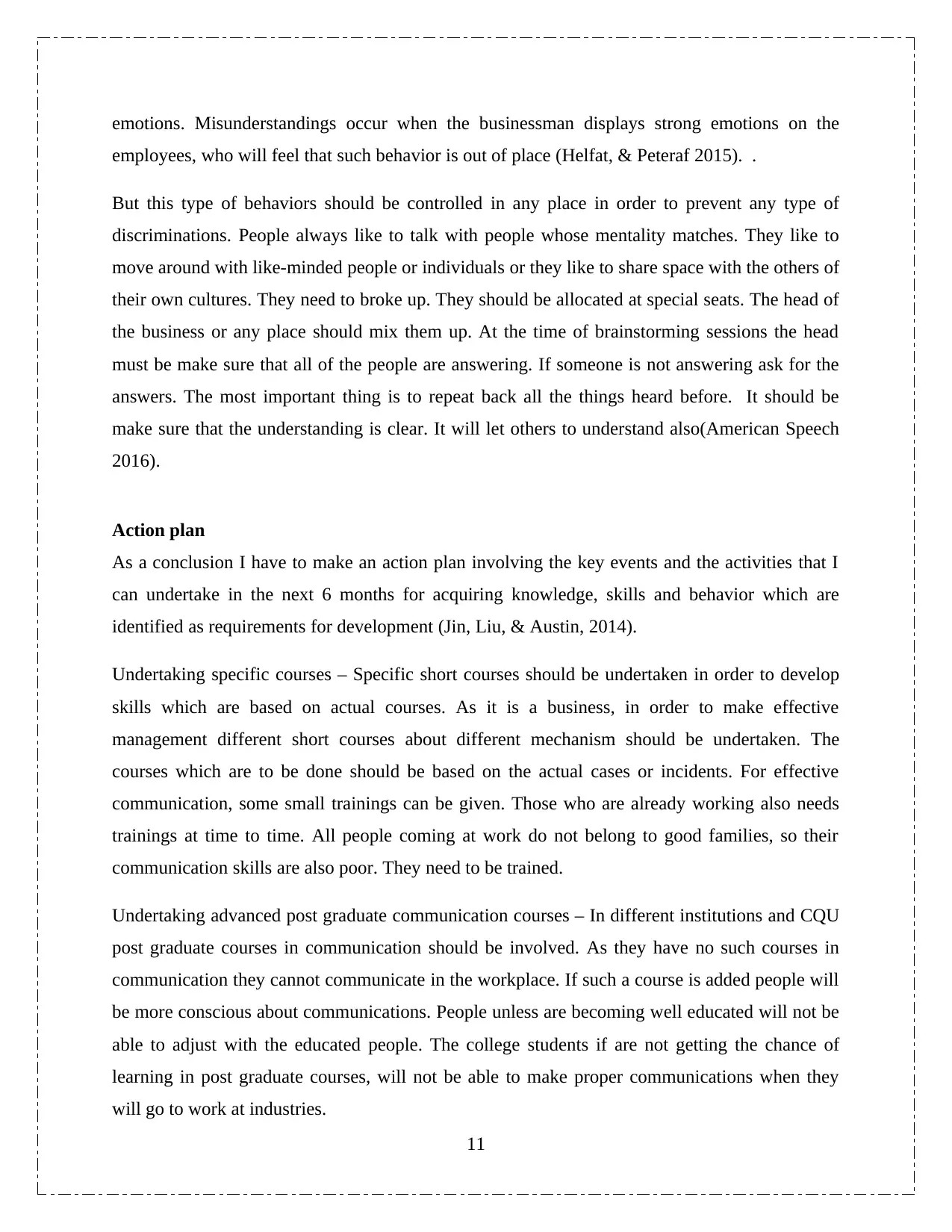
emotions. Misunderstandings occur when the businessman displays strong emotions on the
employees, who will feel that such behavior is out of place (Helfat, & Peteraf 2015). .
But this type of behaviors should be controlled in any place in order to prevent any type of
discriminations. People always like to talk with people whose mentality matches. They like to
move around with like-minded people or individuals or they like to share space with the others of
their own cultures. They need to broke up. They should be allocated at special seats. The head of
the business or any place should mix them up. At the time of brainstorming sessions the head
must be make sure that all of the people are answering. If someone is not answering ask for the
answers. The most important thing is to repeat back all the things heard before. It should be
make sure that the understanding is clear. It will let others to understand also(American Speech
2016).
Action plan
As a conclusion I have to make an action plan involving the key events and the activities that I
can undertake in the next 6 months for acquiring knowledge, skills and behavior which are
identified as requirements for development (Jin, Liu, & Austin, 2014).
Undertaking specific courses – Specific short courses should be undertaken in order to develop
skills which are based on actual courses. As it is a business, in order to make effective
management different short courses about different mechanism should be undertaken. The
courses which are to be done should be based on the actual cases or incidents. For effective
communication, some small trainings can be given. Those who are already working also needs
trainings at time to time. All people coming at work do not belong to good families, so their
communication skills are also poor. They need to be trained.
Undertaking advanced post graduate communication courses – In different institutions and CQU
post graduate courses in communication should be involved. As they have no such courses in
communication they cannot communicate in the workplace. If such a course is added people will
be more conscious about communications. People unless are becoming well educated will not be
able to adjust with the educated people. The college students if are not getting the chance of
learning in post graduate courses, will not be able to make proper communications when they
will go to work at industries.
11
employees, who will feel that such behavior is out of place (Helfat, & Peteraf 2015). .
But this type of behaviors should be controlled in any place in order to prevent any type of
discriminations. People always like to talk with people whose mentality matches. They like to
move around with like-minded people or individuals or they like to share space with the others of
their own cultures. They need to broke up. They should be allocated at special seats. The head of
the business or any place should mix them up. At the time of brainstorming sessions the head
must be make sure that all of the people are answering. If someone is not answering ask for the
answers. The most important thing is to repeat back all the things heard before. It should be
make sure that the understanding is clear. It will let others to understand also(American Speech
2016).
Action plan
As a conclusion I have to make an action plan involving the key events and the activities that I
can undertake in the next 6 months for acquiring knowledge, skills and behavior which are
identified as requirements for development (Jin, Liu, & Austin, 2014).
Undertaking specific courses – Specific short courses should be undertaken in order to develop
skills which are based on actual courses. As it is a business, in order to make effective
management different short courses about different mechanism should be undertaken. The
courses which are to be done should be based on the actual cases or incidents. For effective
communication, some small trainings can be given. Those who are already working also needs
trainings at time to time. All people coming at work do not belong to good families, so their
communication skills are also poor. They need to be trained.
Undertaking advanced post graduate communication courses – In different institutions and CQU
post graduate courses in communication should be involved. As they have no such courses in
communication they cannot communicate in the workplace. If such a course is added people will
be more conscious about communications. People unless are becoming well educated will not be
able to adjust with the educated people. The college students if are not getting the chance of
learning in post graduate courses, will not be able to make proper communications when they
will go to work at industries.
11

A reading plan – People must be much aware about their reading habits as most of them are not
involved in reading. People must learn from different communication texts. People must be
familier with the books. They should be motivated for reading different journals and text books.
The motivation must be given to them from the higher authorities as the workers will abide by
the rules and instructions given by their masters. If the employees cannot read any of the things
the higher authority people may help them in reading. They may clear all the doubts.
Maintaining of personal journals – Each and every company can maintain their personal journals
which reflect on interactions in communications./There are some specific journals which deal
with the interactions in communications. If the employee or any other person gets the habit of
reading journals in communication interactions, the person will gain much knowledge about the
different communication mechanisms. The person will no doubt acquire much knowledge about
the mechanisms of communications. When one person in a group starts a habit of reading
journals and textbooks other persons will also follow him and will start reading journals.
Reference list
American Speech-Language-Hearing Association. (2016). Scope of practice in speech-language
pathology.
Austin, E. W., & Pinkleton, B. E. (2015). Strategic public relations management: Planning and
managing effective communication campaigns (Vol. 10). Routledge.
Bargiela-Chiappini, F., & Nickerson, C. R. (2014). Writing business: Genres, media and
discourses. Routledge.
Cardon, P. W., & Marshall, B. (2015). The hype and reality of social media use for work
collaboration and team communication. International Journal of Business
Communication, 52(3), 273-293.
Certo, S. C. (2018). Supervision: Concepts and skill-building. McGraw-Hill Education.
Deeley, S. J. (2018). Using technology to facilitate effective assessment for learning and
feedback in higher education. Assessment & Evaluation in Higher Education, 43(3), 439-448.
12
involved in reading. People must learn from different communication texts. People must be
familier with the books. They should be motivated for reading different journals and text books.
The motivation must be given to them from the higher authorities as the workers will abide by
the rules and instructions given by their masters. If the employees cannot read any of the things
the higher authority people may help them in reading. They may clear all the doubts.
Maintaining of personal journals – Each and every company can maintain their personal journals
which reflect on interactions in communications./There are some specific journals which deal
with the interactions in communications. If the employee or any other person gets the habit of
reading journals in communication interactions, the person will gain much knowledge about the
different communication mechanisms. The person will no doubt acquire much knowledge about
the mechanisms of communications. When one person in a group starts a habit of reading
journals and textbooks other persons will also follow him and will start reading journals.
Reference list
American Speech-Language-Hearing Association. (2016). Scope of practice in speech-language
pathology.
Austin, E. W., & Pinkleton, B. E. (2015). Strategic public relations management: Planning and
managing effective communication campaigns (Vol. 10). Routledge.
Bargiela-Chiappini, F., & Nickerson, C. R. (2014). Writing business: Genres, media and
discourses. Routledge.
Cardon, P. W., & Marshall, B. (2015). The hype and reality of social media use for work
collaboration and team communication. International Journal of Business
Communication, 52(3), 273-293.
Certo, S. C. (2018). Supervision: Concepts and skill-building. McGraw-Hill Education.
Deeley, S. J. (2018). Using technology to facilitate effective assessment for learning and
feedback in higher education. Assessment & Evaluation in Higher Education, 43(3), 439-448.
12
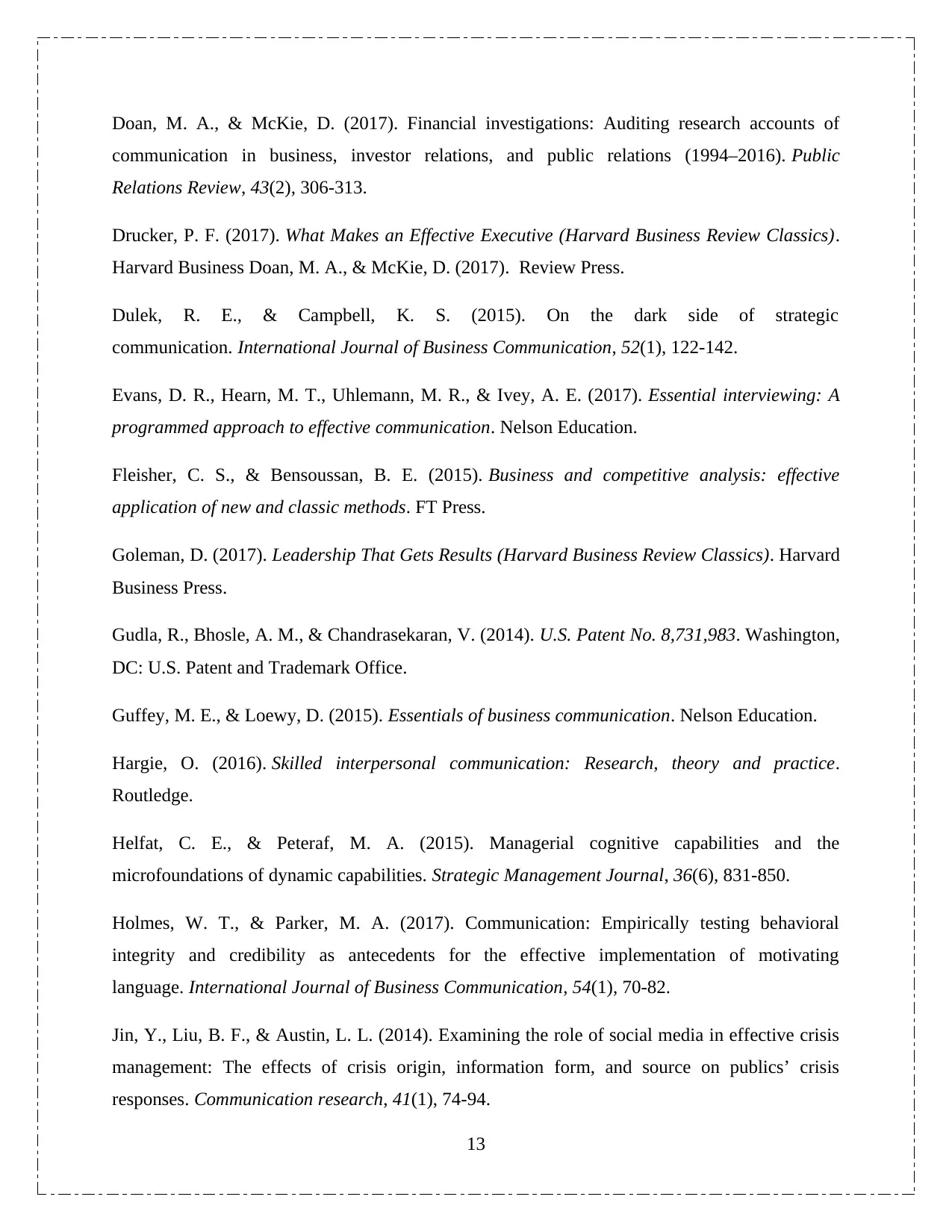
Doan, M. A., & McKie, D. (2017). Financial investigations: Auditing research accounts of
communication in business, investor relations, and public relations (1994–2016). Public
Relations Review, 43(2), 306-313.
Drucker, P. F. (2017). What Makes an Effective Executive (Harvard Business Review Classics).
Harvard Business Doan, M. A., & McKie, D. (2017). Review Press.
Dulek, R. E., & Campbell, K. S. (2015). On the dark side of strategic
communication. International Journal of Business Communication, 52(1), 122-142.
Evans, D. R., Hearn, M. T., Uhlemann, M. R., & Ivey, A. E. (2017). Essential interviewing: A
programmed approach to effective communication. Nelson Education.
Fleisher, C. S., & Bensoussan, B. E. (2015). Business and competitive analysis: effective
application of new and classic methods. FT Press.
Goleman, D. (2017). Leadership That Gets Results (Harvard Business Review Classics). Harvard
Business Press.
Gudla, R., Bhosle, A. M., & Chandrasekaran, V. (2014). U.S. Patent No. 8,731,983. Washington,
DC: U.S. Patent and Trademark Office.
Guffey, M. E., & Loewy, D. (2015). Essentials of business communication. Nelson Education.
Hargie, O. (2016). Skilled interpersonal communication: Research, theory and practice.
Routledge.
Helfat, C. E., & Peteraf, M. A. (2015). Managerial cognitive capabilities and the
microfoundations of dynamic capabilities. Strategic Management Journal, 36(6), 831-850.
Holmes, W. T., & Parker, M. A. (2017). Communication: Empirically testing behavioral
integrity and credibility as antecedents for the effective implementation of motivating
language. International Journal of Business Communication, 54(1), 70-82.
Jin, Y., Liu, B. F., & Austin, L. L. (2014). Examining the role of social media in effective crisis
management: The effects of crisis origin, information form, and source on publics’ crisis
responses. Communication research, 41(1), 74-94.
13
communication in business, investor relations, and public relations (1994–2016). Public
Relations Review, 43(2), 306-313.
Drucker, P. F. (2017). What Makes an Effective Executive (Harvard Business Review Classics).
Harvard Business Doan, M. A., & McKie, D. (2017). Review Press.
Dulek, R. E., & Campbell, K. S. (2015). On the dark side of strategic
communication. International Journal of Business Communication, 52(1), 122-142.
Evans, D. R., Hearn, M. T., Uhlemann, M. R., & Ivey, A. E. (2017). Essential interviewing: A
programmed approach to effective communication. Nelson Education.
Fleisher, C. S., & Bensoussan, B. E. (2015). Business and competitive analysis: effective
application of new and classic methods. FT Press.
Goleman, D. (2017). Leadership That Gets Results (Harvard Business Review Classics). Harvard
Business Press.
Gudla, R., Bhosle, A. M., & Chandrasekaran, V. (2014). U.S. Patent No. 8,731,983. Washington,
DC: U.S. Patent and Trademark Office.
Guffey, M. E., & Loewy, D. (2015). Essentials of business communication. Nelson Education.
Hargie, O. (2016). Skilled interpersonal communication: Research, theory and practice.
Routledge.
Helfat, C. E., & Peteraf, M. A. (2015). Managerial cognitive capabilities and the
microfoundations of dynamic capabilities. Strategic Management Journal, 36(6), 831-850.
Holmes, W. T., & Parker, M. A. (2017). Communication: Empirically testing behavioral
integrity and credibility as antecedents for the effective implementation of motivating
language. International Journal of Business Communication, 54(1), 70-82.
Jin, Y., Liu, B. F., & Austin, L. L. (2014). Examining the role of social media in effective crisis
management: The effects of crisis origin, information form, and source on publics’ crisis
responses. Communication research, 41(1), 74-94.
13
Paraphrase This Document
Need a fresh take? Get an instant paraphrase of this document with our AI Paraphraser
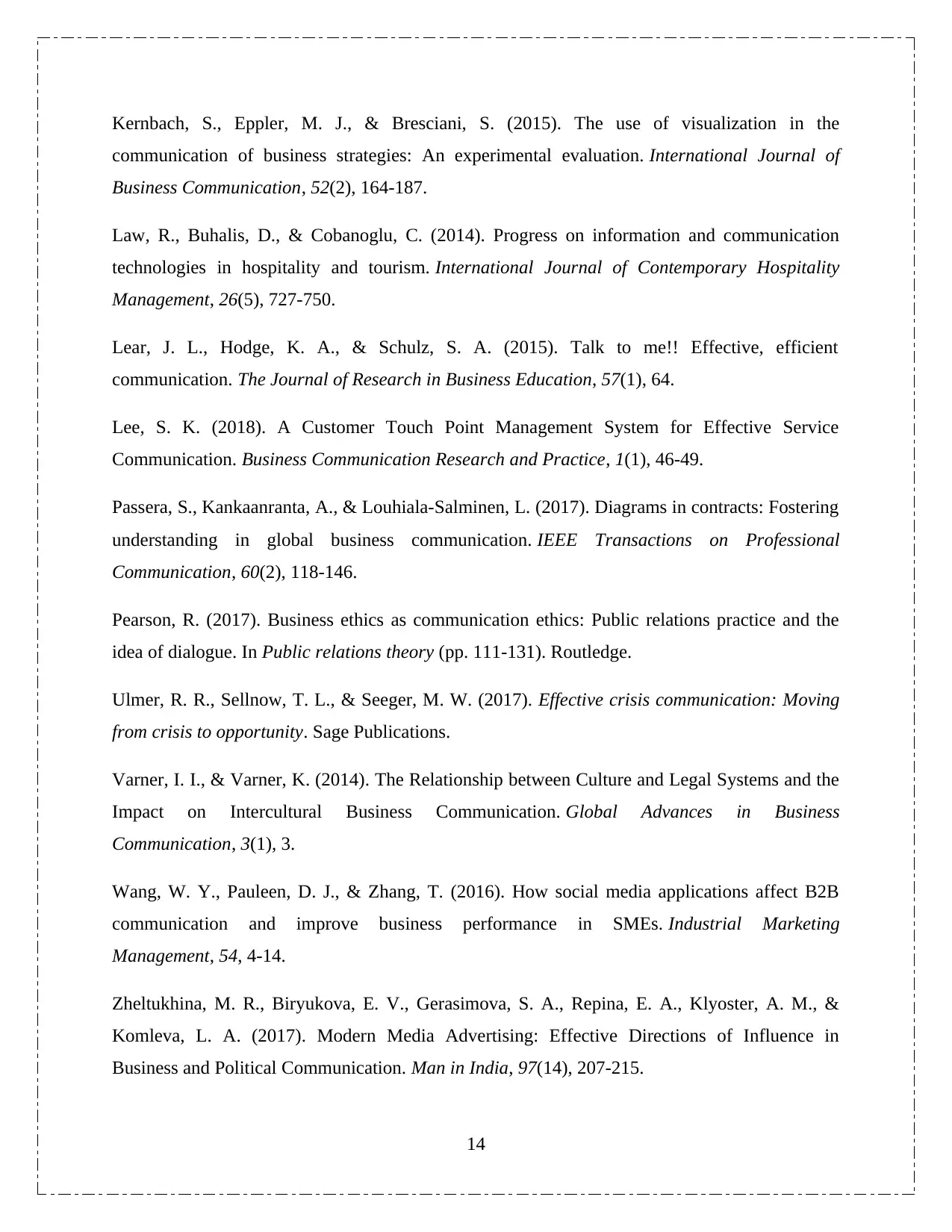
Kernbach, S., Eppler, M. J., & Bresciani, S. (2015). The use of visualization in the
communication of business strategies: An experimental evaluation. International Journal of
Business Communication, 52(2), 164-187.
Law, R., Buhalis, D., & Cobanoglu, C. (2014). Progress on information and communication
technologies in hospitality and tourism. International Journal of Contemporary Hospitality
Management, 26(5), 727-750.
Lear, J. L., Hodge, K. A., & Schulz, S. A. (2015). Talk to me!! Effective, efficient
communication. The Journal of Research in Business Education, 57(1), 64.
Lee, S. K. (2018). A Customer Touch Point Management System for Effective Service
Communication. Business Communication Research and Practice, 1(1), 46-49.
Passera, S., Kankaanranta, A., & Louhiala-Salminen, L. (2017). Diagrams in contracts: Fostering
understanding in global business communication. IEEE Transactions on Professional
Communication, 60(2), 118-146.
Pearson, R. (2017). Business ethics as communication ethics: Public relations practice and the
idea of dialogue. In Public relations theory (pp. 111-131). Routledge.
Ulmer, R. R., Sellnow, T. L., & Seeger, M. W. (2017). Effective crisis communication: Moving
from crisis to opportunity. Sage Publications.
Varner, I. I., & Varner, K. (2014). The Relationship between Culture and Legal Systems and the
Impact on Intercultural Business Communication. Global Advances in Business
Communication, 3(1), 3.
Wang, W. Y., Pauleen, D. J., & Zhang, T. (2016). How social media applications affect B2B
communication and improve business performance in SMEs. Industrial Marketing
Management, 54, 4-14.
Zheltukhina, M. R., Biryukova, E. V., Gerasimova, S. A., Repina, E. A., Klyoster, A. M., &
Komleva, L. A. (2017). Modern Media Advertising: Effective Directions of Influence in
Business and Political Communication. Man in India, 97(14), 207-215.
14
communication of business strategies: An experimental evaluation. International Journal of
Business Communication, 52(2), 164-187.
Law, R., Buhalis, D., & Cobanoglu, C. (2014). Progress on information and communication
technologies in hospitality and tourism. International Journal of Contemporary Hospitality
Management, 26(5), 727-750.
Lear, J. L., Hodge, K. A., & Schulz, S. A. (2015). Talk to me!! Effective, efficient
communication. The Journal of Research in Business Education, 57(1), 64.
Lee, S. K. (2018). A Customer Touch Point Management System for Effective Service
Communication. Business Communication Research and Practice, 1(1), 46-49.
Passera, S., Kankaanranta, A., & Louhiala-Salminen, L. (2017). Diagrams in contracts: Fostering
understanding in global business communication. IEEE Transactions on Professional
Communication, 60(2), 118-146.
Pearson, R. (2017). Business ethics as communication ethics: Public relations practice and the
idea of dialogue. In Public relations theory (pp. 111-131). Routledge.
Ulmer, R. R., Sellnow, T. L., & Seeger, M. W. (2017). Effective crisis communication: Moving
from crisis to opportunity. Sage Publications.
Varner, I. I., & Varner, K. (2014). The Relationship between Culture and Legal Systems and the
Impact on Intercultural Business Communication. Global Advances in Business
Communication, 3(1), 3.
Wang, W. Y., Pauleen, D. J., & Zhang, T. (2016). How social media applications affect B2B
communication and improve business performance in SMEs. Industrial Marketing
Management, 54, 4-14.
Zheltukhina, M. R., Biryukova, E. V., Gerasimova, S. A., Repina, E. A., Klyoster, A. M., &
Komleva, L. A. (2017). Modern Media Advertising: Effective Directions of Influence in
Business and Political Communication. Man in India, 97(14), 207-215.
14

15
1 out of 15
Related Documents
Your All-in-One AI-Powered Toolkit for Academic Success.
+13062052269
info@desklib.com
Available 24*7 on WhatsApp / Email
![[object Object]](/_next/static/media/star-bottom.7253800d.svg)
Unlock your academic potential
© 2024 | Zucol Services PVT LTD | All rights reserved.





